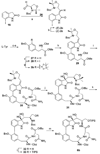Total synthesis of TMC-95A and -B via a new reaction leading to Z-enamides. Some preliminary findings as to SAR
- PMID: 15149232
- PMCID: PMC2507741
- DOI: 10.1021/ja049821k
Total synthesis of TMC-95A and -B via a new reaction leading to Z-enamides. Some preliminary findings as to SAR
Abstract
A full account of the total syntheses of proteasome inhibitors TMC-95A and -B is provided. A key feature of the syntheses involved installation of a cis-propenylamide moiety by a thermal rearrangement of an alpha-silylallyl amide. The scope and mechanism of the enamide-forming reaction are discussed. Also provided are some preliminary results from SAR studies. It was found that simplified analogues can retain the full potency of proteasome inhibition.
Figures













Similar articles
-
Simplified synthetic TMC-95A/B analogues retain the potency of proteasome inhibitory activity.Chembiochem. 2003 Jun 6;4(6):508-13. doi: 10.1002/cbic.200300560. Chembiochem. 2003. PMID: 12794861 Free PMC article.
-
The total synthesis of proteasome inhibitors TMC-95A and TMC-95B: discovery of a new method to generate cis-propenyl amides.Angew Chem Int Ed Engl. 2002 Feb 1;41(3):512-5. doi: 10.1002/1521-3773(20020201)41:3<512::aid-anie512>3.0.co;2-r. Angew Chem Int Ed Engl. 2002. PMID: 12491396 No abstract available.
-
A concise formal total synthesis of TMC-95A/B proteasome inhibitors.Org Lett. 2003 Jan 23;5(2):197-200. doi: 10.1021/ol0272545. Org Lett. 2003. PMID: 12529139
-
Recent advances in the identification and development of 20S proteasome inhibitors.Mini Rev Med Chem. 2002 Jun;2(3):247-59. doi: 10.2174/1389557023406142. Mini Rev Med Chem. 2002. PMID: 12370066 Review.
-
Proteasome inhibitors.Prog Mol Subcell Biol. 2002;29:110-25. Prog Mol Subcell Biol. 2002. PMID: 11908069 Review. No abstract available.
Cited by
-
Inhibition of human and yeast 20S proteasome by analogues of trypsin inhibitor SFTI-1.PLoS One. 2014 Feb 25;9(2):e89465. doi: 10.1371/journal.pone.0089465. eCollection 2014. PLoS One. 2014. PMID: 24586798 Free PMC article.
-
Natural product scaffolds as inspiration for the design and synthesis of 20S human proteasome inhibitors.RSC Chem Biol. 2020 Dec 1;1(5):305-332. doi: 10.1039/d0cb00111b. Epub 2020 Sep 16. RSC Chem Biol. 2020. PMID: 33791679 Free PMC article.
-
Revisiting the Kinnel-Scheuer hypothesis for the biosynthesis of palau'amine.Chem Commun (Camb). 2011 Jan 7;47(1):427-9. doi: 10.1039/c0cc02214d. Epub 2010 Sep 16. Chem Commun (Camb). 2011. PMID: 20848010 Free PMC article.
-
Macrocyclic Oxindole Peptide Epoxyketones-A Comparative Study of Macrocyclic Inhibitors of the 20S Proteasome.ACS Med Chem Lett. 2024 Mar 27;15(4):533-539. doi: 10.1021/acsmedchemlett.4c00017. eCollection 2024 Apr 11. ACS Med Chem Lett. 2024. PMID: 38628795 Free PMC article.
-
Access to 3,3-disubstituted oxindoles via microwave-assisted Cannizzaro and aldol reactions of formaldehyde with isatins and their imines.RSC Adv. 2021 May 11;11(28):17320-17323. doi: 10.1039/d1ra02150h. eCollection 2021 May 6. RSC Adv. 2021. PMID: 35479673 Free PMC article.
References
Publication types
MeSH terms
Substances
Grants and funding
LinkOut - more resources
Full Text Sources
Other Literature Sources
Miscellaneous

